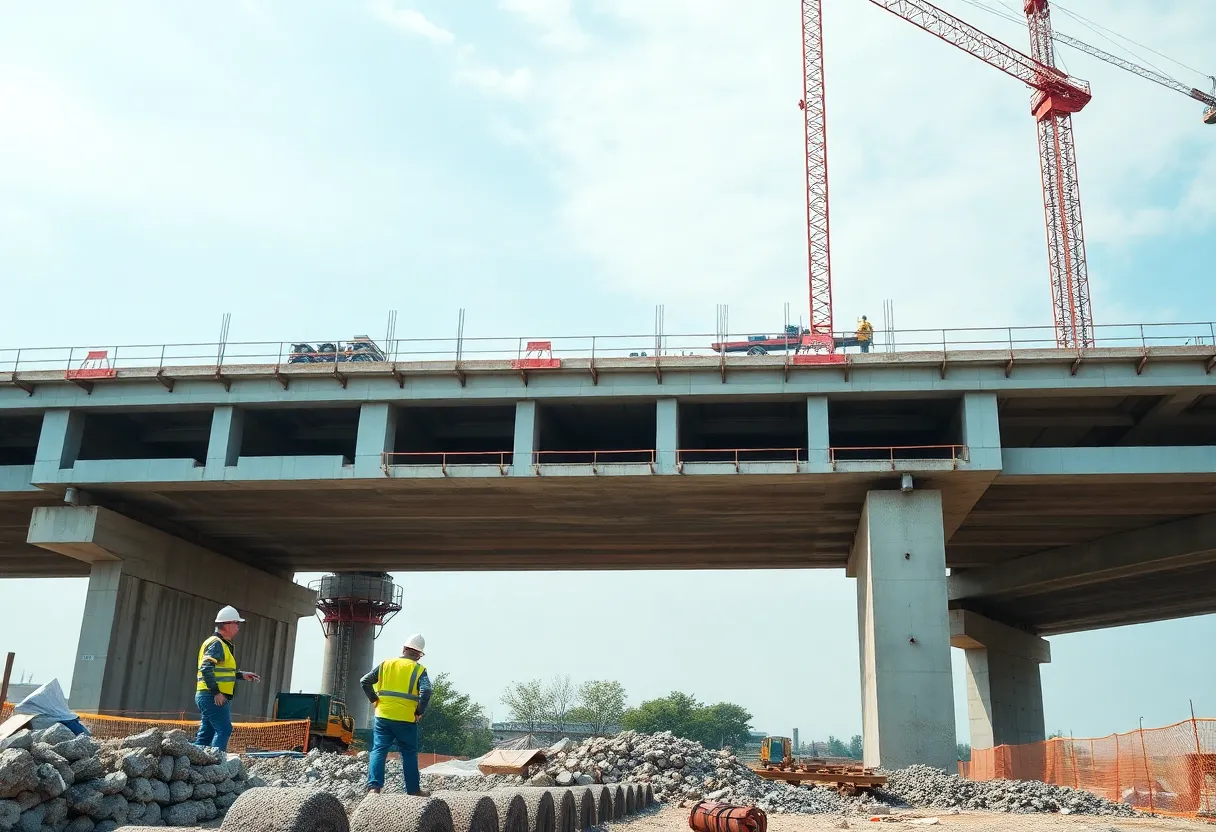Shenyang, China, August 11, 2025
News Summary
A study in Shenyang, China, explored how various construction control parameters affect the cantilever construction of prestressed concrete continuous girder bridges. Key factors include temperature variations and prestressing loss, which significantly influence bridge alignment and stress during construction. The research highlighted the need for constant monitoring to ensure structural safety and integrity. It is emphasized that integrating advanced technologies like BIM and IoT can improve construction outcomes and adherence to safety standards.
Shenyang, China – A comprehensive study has utilized finite element modeling to investigate the effects of various construction control parameters on the cantilever construction of prestressed concrete continuous girder bridges. Key parameters analyzed in the research include concrete unit weight, elastic modulus, prestressing loss, concrete shrinkage and creep, and temperature variations. The findings reveal that temperature variations and prestressing loss have significant effects on both bridge alignment and stress states during different stages of construction.
This study emphasizes the critical need for ongoing monitoring of parameters that have a substantial impact on alignment and stress to facilitate successful bridge construction. The research draws attention to the growing adoption of prestressed concrete continuous girder bridges due to their benefits, including enhanced structural stiffness, integrity, and cost-effectiveness.
Construction errors alongside material properties and ambient environmental factors often result in discrepancies between actual structural parameters and theoretical models during the cantilever casting of bridge segments. As part of the research, a construction monitoring system was initiated, which takes into account the interactions among these vital construction control parameters.
Data collected from real-time monitoring on the Shenyang Metro Line 3 project, conducted from October 2023 to August 2024, illustrates the various impacts of temperature and prestressing loss. The study’s finite element model effectively simulates the entire construction sequence, including stages such as concrete pouring and steel strand tensioning.
A thorough sensitivity analysis was performed, demonstrating how control parameters influence overall bridge performance during both final completion and maximum cantilever conditions. Observations indicated that parameter effects are more significant at the final-completed state compared to maximum cantilever state, pointing to the necessity for meticulous monitoring as construction progresses.
The monitoring systems implemented addressed key aspects, including stress monitoring, geometric stability, and temperature variations, all crucial for assessing impacts on bridge construction. Furthermore, the study established the intervention limits for parameter variations and shed light on the nonlinear interactions among different parameters.
In total, the research tested a series of twelve load-case combinations to observe variances in deflection and stress under challenging parameter sets, enabling the development of proposed early-warning thresholds. These thresholds highlighted a maximum allowable deflection difference of 25.73 mm, and for stress, critiqued differences of 5.13 MPa and -9.26 MPa, applicable to the top and bottom slabs, respectively.
The study underscores the importance of quality management in construction processes, especially regarding prestressing equipment and managing temperature operations. Recommendations for future projects include the integration of Building Information Modeling (BIM) and Internet of Things (IoT) technologies for enhanced real-time monitoring and parameter adjustment, ensuring structural safety and integrity of these bridges.
In summary, the research signifies that all monitored parameters during construction should be meticulously overseen to maintain the safety and reliability of prestressed concrete continuous girder bridges.
FAQ
What are prestressed concrete continuous girder bridges?
Prestressed concrete continuous girder bridges are designed to provide superior structural stiffness and integrity by using prestressed concrete which allows for greater load capacity and durability.
Why is monitoring construction parameters important?
Monitoring construction parameters is crucial to identify deviations that could affect bridge alignment and structural integrity, ensuring safe and effective construction outcomes.
What were the primary factors influencing bridge construction in the study?
The study found that temperature variations and prestressing loss were the most influential factors on bridge deflection and stress during the cantilever construction process.
Key Features
| Feature | Description |
|---|---|
| Finite Element Modeling | A method used to simulate and analyze construction processes and structural performance. |
| Construction Control Parameters | Temperature, prestressing loss, concrete unit weight, elastic modulus, creep, and shrinkage. |
| Real-time Monitoring | Continuous data collection to assess construction impacts from October 2023 to August 2024. |
| Proposed Early-Warning Thresholds | Max deflection difference of 25.73 mm; stress limits of 5.13 MPa and -9.26 MPa. |
| Future Recommendations | Utilization of BIM and IoT technologies for improved monitoring and parameter calibration. |
Deeper Dive: News & Info About This Topic
HERE Resources
Additional Resources
- Nature: Construction Control Parameters
- Wikipedia: Bridge
- Chosun: North Korea News
- Google Search: Prestressed Concrete Bridges
- Wiley Online Library: Engineering Research
- Encyclopedia Britannica: Structural Engineering
- VOA News: China-North Korea Rail Link
- Google News: Construction Monitoring
- Smithsonian: Beautiful Bridges
- Google Scholar: Finite Element Modeling
Author: STAFF HERE HOUSTON TX WRITER
The HOUSTON STAFF WRITER represents the experienced team at HEREHouston.com, your go-to source for actionable local news and information in Houston, Harris County, and beyond. Specializing in "news you can use," we cover essential topics like product reviews for personal and business needs, local business directories, politics, real estate trends, neighborhood insights, and state news affecting the area—with deep expertise drawn from years of dedicated reporting and strong community input, including local press releases and business updates. We deliver top reporting on high-value events such as Houston Livestock Show and Rodeo, Art Car Parade, and Chevron Houston Marathon. Our coverage extends to key organizations like the Greater Houston Partnership and Houston Area Urban League, plus leading businesses in energy and healthcare that power the local economy such as ExxonMobil, Schlumberger, and Houston Methodist. As part of the broader HERE network, including HEREAustinTX.com, HERECollegeStation.com, HEREDallas.com, and HERESanAntonio.com, we provide comprehensive, credible insights into Texas's dynamic landscape.





